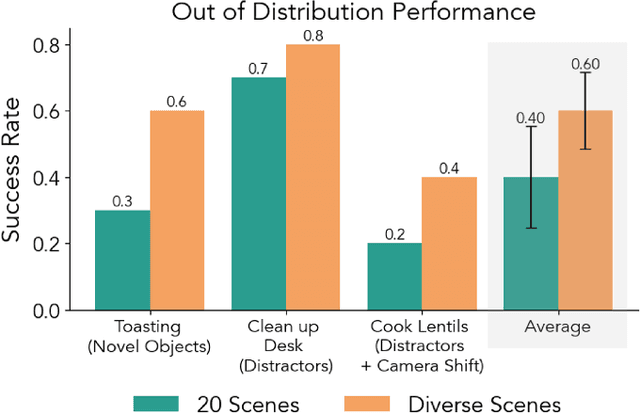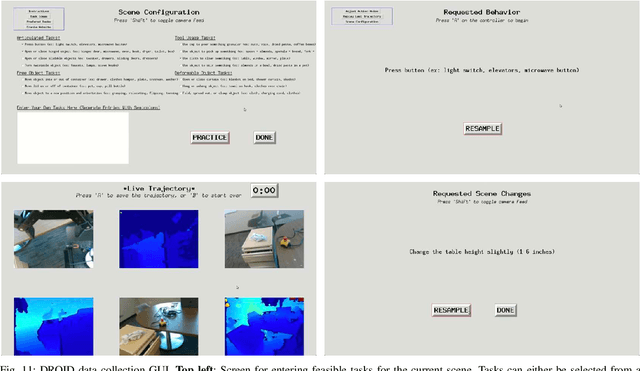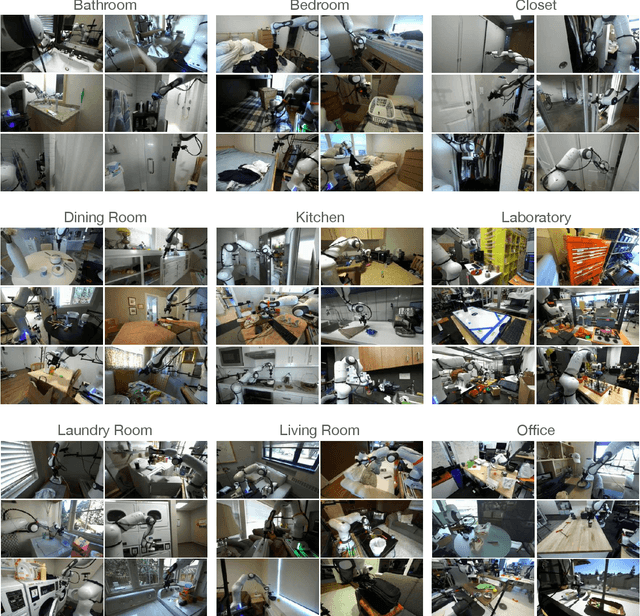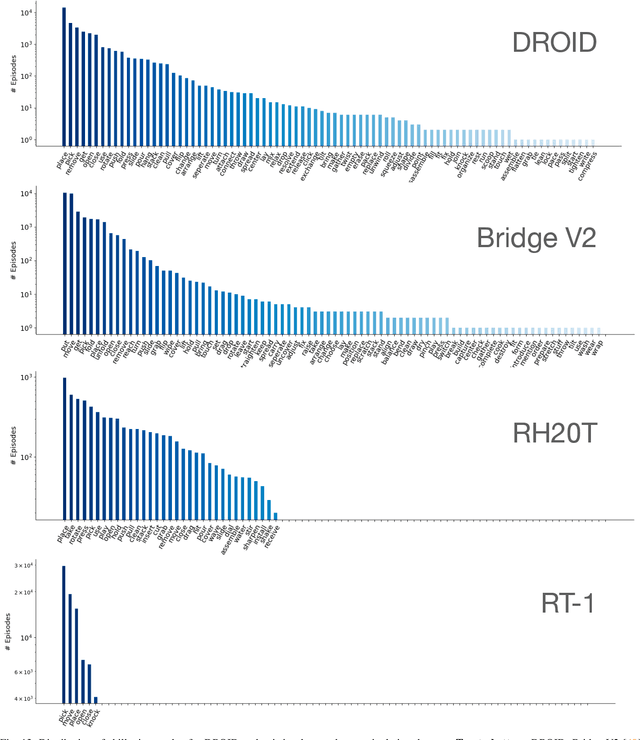Michael C. Yip
Differentiable Rendering-based Pose Estimation for Surgical Robotic Instruments
Mar 07, 2025Abstract:Robot pose estimation is a challenging and crucial task for vision-based surgical robotic automation. Typical robotic calibration approaches, however, are not applicable to surgical robots, such as the da Vinci Research Kit (dVRK), due to joint angle measurement errors from cable-drives and the partially visible kinematic chain. Hence, previous works in surgical robotic automation used tracking algorithms to estimate the pose of the surgical tool in real-time and compensate for the joint angle errors. However, a big limitation of these previous tracking works is the initialization step which relied on only keypoints and SolvePnP. In this work, we fully explore the potential of geometric primitives beyond just keypoints with differentiable rendering, cylinders, and construct a versatile pose matching pipeline in a novel pose hypothesis space. We demonstrate the state-of-the-art performance of our single-shot calibration method with both calibration consistency and real surgical tasks. As a result, this marker-less calibration approach proves to be a robust and generalizable initialization step for surgical tool tracking.
Back to Base: Towards Hands-Off Learning via Safe Resets with Reach-Avoid Safety Filters
Jan 05, 2025Abstract:Designing controllers that accomplish tasks while guaranteeing safety constraints remains a significant challenge. We often want an agent to perform well in a nominal task, such as environment exploration, while ensuring it can avoid unsafe states and return to a desired target by a specific time. In particular we are motivated by the setting of safe, efficient, hands-off training for reinforcement learning in the real world. By enabling a robot to safely and autonomously reset to a desired region (e.g., charging stations) without human intervention, we can enhance efficiency and facilitate training. Safety filters, such as those based on control barrier functions, decouple safety from nominal control objectives and rigorously guarantee safety. Despite their success, constructing these functions for general nonlinear systems with control constraints and system uncertainties remains an open problem. This paper introduces a safety filter obtained from the value function associated with the reach-avoid problem. The proposed safety filter minimally modifies the nominal controller while avoiding unsafe regions and guiding the system back to the desired target set. By preserving policy performance while allowing safe resetting, we enable efficient hands-off reinforcement learning and advance the feasibility of safe training for real world robots. We demonstrate our approach using a modified version of soft actor-critic to safely train a swing-up task on a modified cartpole stabilization problem.
Haptic Shoulder for Rendering Biomechanically Accurate Joint Limits for Human-Robot Physical Interactions
Sep 20, 2024Abstract:Human-robot physical interaction (pHRI) is a rapidly evolving research field with significant implications for physical therapy, search and rescue, and telemedicine. However, a major challenge lies in accurately understanding human constraints and safety in human-robot physical experiments without an IRB and physical human experiments. Concerns regarding human studies include safety concerns, repeatability, and scalability of the number and diversity of participants. This paper examines whether a physical approximation can serve as a stand-in for human subjects to enhance robot autonomy for physical assistance. This paper introduces the SHULDRD (Shoulder Haptic Universal Limb Dynamic Repositioning Device), an economical and anatomically similar device designed for real-time testing and deployment of pHRI planning tasks onto robots in the real world. SHULDRD replicates human shoulder motion, providing crucial force feedback and safety data. The device's open-source CAD and software facilitate easy construction and use, ensuring broad accessibility for researchers. By providing a flexible platform able to emulate infinite human subjects, ensure repeatable trials, and provide quantitative metrics to assess the effectiveness of the robotic intervention, SHULDRD aims to improve the safety and efficacy of human-robot physical interactions.
CtRNet-X: Camera-to-Robot Pose Estimation in Real-world Conditions Using a Single Camera
Sep 16, 2024Abstract:Camera-to-robot calibration is crucial for vision-based robot control and requires effort to make it accurate. Recent advancements in markerless pose estimation methods have eliminated the need for time-consuming physical setups for camera-to-robot calibration. While the existing markerless pose estimation methods have demonstrated impressive accuracy without the need for cumbersome setups, they rely on the assumption that all the robot joints are visible within the camera's field of view. However, in practice, robots usually move in and out of view, and some portion of the robot may stay out-of-frame during the whole manipulation task due to real-world constraints, leading to a lack of sufficient visual features and subsequent failure of these approaches. To address this challenge and enhance the applicability to vision-based robot control, we propose a novel framework capable of estimating the robot pose with partially visible robot manipulators. Our approach leverages the Vision-Language Models for fine-grained robot components detection, and integrates it into a keypoint-based pose estimation network, which enables more robust performance in varied operational conditions. The framework is evaluated on both public robot datasets and self-collected partial-view datasets to demonstrate our robustness and generalizability. As a result, this method is effective for robot pose estimation in a wider range of real-world manipulation scenarios.
Autonomous Image-to-Grasp Robotic Suturing Using Reliability-Driven Suture Thread Reconstruction
Aug 29, 2024Abstract:Automating suturing during robotically-assisted surgery reduces the burden on the operating surgeon, enabling them to focus on making higher-level decisions rather than fatiguing themselves in the numerous intricacies of a surgical procedure. Accurate suture thread reconstruction and grasping are vital prerequisites for suturing, particularly for avoiding entanglement with surgical tools and performing complex thread manipulation. However, such methods must be robust to heavy perceptual degradation resulting from heavy noise and thread feature sparsity from endoscopic images. We develop a reconstruction algorithm that utilizes quadratic programming optimization to fit smooth splines to thread observations, satisfying reliability bounds estimated from measured observation noise. Additionally, we craft a grasping policy that generates gripper trajectories that maximize the probability of a successful grasp. Our full image-to-grasp pipeline is rigorously evaluated with over 400 grasping trials, exhibiting state-of-the-art accuracy. We show that this strategy can be applied to the various techniques in autonomous suture needle manipulation to achieve autonomous surgery in a generalizable way.
JIGGLE: An Active Sensing Framework for Boundary Parameters Estimation in Deformable Surgical Environments
May 16, 2024Abstract:Surgical automation can improve the accessibility and consistency of life saving procedures. Most surgeries require separating layers of tissue to access the surgical site, and suturing to reattach incisions. These tasks involve deformable manipulation to safely identify and alter tissue attachment (boundary) topology. Due to poor visual acuity and frequent occlusions, surgeons tend to carefully manipulate the tissue in ways that enable inference of the tissue's attachment points without causing unsafe tearing. In a similar fashion, we propose JIGGLE, a framework for estimation and interactive sensing of unknown boundary parameters in deformable surgical environments. This framework has two key components: (1) a probabilistic estimation to identify the current attachment points, achieved by integrating a differentiable soft-body simulator with an extended Kalman filter (EKF), and (2) an optimization-based active control pipeline that generates actions to maximize information gain of the tissue attachments, while simultaneously minimizing safety costs. The robustness of our estimation approach is demonstrated through experiments with real animal tissue, where we infer sutured attachment points using stereo endoscope observations. We also demonstrate the capabilities of our method in handling complex topological changes such as cutting and suturing.
SURESTEP: An Uncertainty-Aware Trajectory Optimization Framework to Enhance Visual Tool Tracking for Robust Surgical Automation
Mar 29, 2024Abstract:Inaccurate tool localization is one of the main reasons for failures in automating surgical tasks. Imprecise robot kinematics and noisy observations caused by the poor visual acuity of an endoscopic camera make tool tracking challenging. Previous works in surgical automation adopt environment-specific setups or hard-coded strategies instead of explicitly considering motion and observation uncertainty of tool tracking in their policies. In this work, we present SURESTEP, an uncertainty-aware trajectory optimization framework for robust surgical automation. We model the uncertainty of tool tracking with the components motivated by the sources of noise in typical surgical scenes. Using a Gaussian assumption to propagate our uncertainty models through a given tool trajectory, SURESTEP provides a general framework that minimizes the upper bound on the entropy of the final estimated tool distribution. We compare SURESTEP with a baseline method on a real-world suture needle regrasping task under challenging environmental conditions, such as poor lighting and a moving endoscopic camera. The results over 60 regrasps on the da Vinci Research Kit (dVRK) demonstrate that our optimized trajectories significantly outperform the un-optimized baseline.
HemoSet: The First Blood Segmentation Dataset for Automation of Hemostasis Management
Mar 24, 2024



Abstract:Hemorrhaging occurs in surgeries of all types, forcing surgeons to quickly adapt to the visual interference that results from blood rapidly filling the surgical field. Introducing automation into the crucial surgical task of hemostasis management would offload mental and physical tasks from the surgeon and surgical assistants while simultaneously increasing the efficiency and safety of the operation. The first step in automation of hemostasis management is detection of blood in the surgical field. To propel the development of blood detection algorithms in surgeries, we present HemoSet, the first blood segmentation dataset based on bleeding during a live animal robotic surgery. Our dataset features vessel hemorrhage scenarios where turbulent flow leads to abnormal pooling geometries in surgical fields. These pools are formed in conditions endemic to surgical procedures -- uneven heterogeneous tissue, under glossy lighting conditions and rapid tool movement. We benchmark several state-of-the-art segmentation models and provide insight into the difficulties specific to blood detection. We intend for HemoSet to spur development of autonomous blood suction tools by providing a platform for training and refining blood segmentation models, addressing the precision needed for such robotics.
DROID: A Large-Scale In-The-Wild Robot Manipulation Dataset
Mar 19, 2024



Abstract:The creation of large, diverse, high-quality robot manipulation datasets is an important stepping stone on the path toward more capable and robust robotic manipulation policies. However, creating such datasets is challenging: collecting robot manipulation data in diverse environments poses logistical and safety challenges and requires substantial investments in hardware and human labour. As a result, even the most general robot manipulation policies today are mostly trained on data collected in a small number of environments with limited scene and task diversity. In this work, we introduce DROID (Distributed Robot Interaction Dataset), a diverse robot manipulation dataset with 76k demonstration trajectories or 350 hours of interaction data, collected across 564 scenes and 84 tasks by 50 data collectors in North America, Asia, and Europe over the course of 12 months. We demonstrate that training with DROID leads to policies with higher performance and improved generalization ability. We open source the full dataset, policy learning code, and a detailed guide for reproducing our robot hardware setup.
Robust Surgical Tool Tracking with Pixel-based Probabilities for Projected Geometric Primitives
Mar 08, 2024



Abstract:Controlling robotic manipulators via visual feedback requires a known coordinate frame transformation between the robot and the camera. Uncertainties in mechanical systems as well as camera calibration create errors in this coordinate frame transformation. These errors result in poor localization of robotic manipulators and create a significant challenge for applications that rely on precise interactions between manipulators and the environment. In this work, we estimate the camera-to-base transform and joint angle measurement errors for surgical robotic tools using an image based insertion-shaft detection algorithm and probabilistic models. We apply our proposed approach in both a structured environment as well as an unstructured environment and measure to demonstrate the efficacy of our methods.
 Add to Chrome
Add to Chrome Add to Firefox
Add to Firefox Add to Edge
Add to Edge